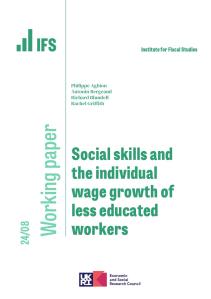There is a current debate about whether the definition of self-employment should be aligned across tax and employment law. At present there is a rather complex situation – illustrated by a recent court case involving Pimlico Plumbers – in which an individual can be deemed a worker in employment law but self-employed in tax law. The definitions matter because they determine who gets access to employment rights and who gets preferential tax treatment.
There would be a simplification gain from aligning the rules used for defining self-employment for the purpose of employment rights and tax status. However, there is not a principled reason for alignment; employment law and tax are distinct policy instruments with distinct aims. The characteristics defining when a worker should be provided certain rights need not be the same as those that defining which types the work the government would like to tax at higher rates. One argument made in favour of alignment is that it would allow higher taxes on employees relative to the self-employed to be used to offset any advantages that the former group receive from employment rights. This is a logically flawed argument since employment rights do not work to favour employment. More broadly, aside from the small differences in entitlement to state benefits, it is difficult to justify any degree of tax difference between different legal forms of work, and the presence of such a difference, far from offsetting benefits associated with employment rights, acts to drive changes in the structure of work.
There is an unjustified tax advantage to self-employment
The UK tax system attaches a significant tax penalty to work that occurs through employment. For example, a job that generates £40,000 of income in a year (i.e. that is the total amount that someone pays to have the job done) will attract tax of £12,023 if carried out by an employee but just £8,472 if the person is self-employed. Most of the difference stems from employer National Insurance contributions (NICs), a 13.8% tax levied on salaries (above a threshold) paid to employees. Work done through self-employment faces no equivalent of employer NICs and the main rate of self-employed NICs is lower than the main rate of employee NICs (9% vs 12%). Employer NICs are handed to the government by employers, but they should be seen as a tax on work that occurs through employment. To the extent that employers face the cost of employer NICs, they will be less attracted to employing people. The market may well adjust such that the going wage for employees falls in response to employers NICs, making employment less attractive to employees. But regardless of how the labour market adjusts, employer NICs act to disincentivise employment in a way that it does not disincentivise self-employment.
The government has not stated clearly why it thinks the tax advantage for self-employment should exist. While in principle lower taxes on the self-employed could be justified by differences in access to publicly funded benefits, in practice the scale of the differences in benefit entitlements is far too small to justify the scale of tax differences that exist. And lower taxes on the self-employed are not well targeted at encouraging entrepreneurship. (We discuss these points further in the IFS Green Budget 2017.) As argued in the government-commissioned Taylor Review, ’treating different forms of employment more equally in the tax system would be fairer, more economically efficient and support better quality work.’
Employment rights do not bias the labour market towards employment
Employment rights, including minimum wages, automatic enrolment into workplace pensions, statutory minimum holiday, sick and redundancy pay, and statutory maternity/paternity/adoption/shared parental leave, are benefits that the government requires employers to give to their employees. That is, they are a transfer of resources between the parties within an employment relationship. Employment rights are not paid for by the government.
Employment rights do not bias the labour market towards employment. In some cases employment rights won’t affect what employers offer. For example, employers regularly use rights or benefits, such as holiday or maternity pay or workplace pension arrangements, that are more generous than minimum requirements as part of remuneration packages to attract and retain the best staff. We would expect employers to be particularly keen to provide benefits that are worth more to employees than they cost the employer to provide (since this is a cost-effective way to remunerate staff). If employment rights do affect what employers offer, they create a transfer between employer and employee that would not otherwise have happened. This may result in a wage adjustment (i.e. wages may fall to reflect the increase in benefits), offsetting the attraction of employment rights to potential employees. To the extent that wages do not adjust to reflect the full value of the benefit, employment rights make employment more attractive to employees (because they are getting an additional right or benefit that is not fully reflected in a lower salary) but less attractive for employers (because they have to cover the cost of the rights that are not recouped through a lower wage). In either case, the bottom line is that employment rights do not act to bias the labour market overall towards employment. In some cases (where employees don’t value the rights as much as they cost employers to provide) they can bias the market away from employment. There may be good reasons to impose employment rights that, overall, act to discourage employment relative to self-employment. For example, the government may determine that certain practices should not be allowed, even if it reduces employment. These are the types of issues that must be considered when designing employment rights.
Lower employment rights do not justify lower taxes
It may be tempting to think that employees are getting a benefit (such as holiday pay) that the self-employed are not and that the former should therefore be taxed at higher rates to offset this benefit. This is a common misconception. It is a logically flawed argument. The key to understanding this is to recall that there are two sides to an employment relationship. Employment rights may make employment more attractive to employees. Higher taxes on employees may therefore look like they simply offset the benefits conferred by employment rights. But the very same rights make employment less attractive to employers and, on this side of the market, higher taxes on employment also give an incentive for employers to choose independent contractors over employees. Taking these two sides together, there is no overall advantage to employment to be offset using the tax system. If any bias is introduced by employment rights, it is away from employment. In this case, tax can reinforce this disincentive and encourage the labour market towards a greater use of independent contractors.
Government should set out who they want to give rights and tax breaks to
In summary, the presence of employment rights should not be interpreted as the government favouring employment over self-employment overall in a way that might justify an offsetting tax differential. Tax differences across legal forms simply act to bias the labour market away from employment and towards self-employment and they do this regardless of how employment rights are designed. If the government wants to justify the current preferential tax treatment of the self-employed it needs a justification that does not appeal to differences in employment rights. Government-funded benefits potentially offer a valid justification, but only for a very small difference in tax treatment, nothing like the disparity we currently have.
If we keep substantial tax differences, there needs to be a set of criteria that determine which forms of work should get access to the lower tax rates; this is difficult to do without a clear rationale for having the tax differences in the first place, and any dividing line provides an incentive to reshape some behaviours. In a similar vein, employment rights require a dividing line, or lines, that define which types of worker should have access to which rights. It is possible that the characteristics that define those workers that the government decides should be provided certain rights will the same as, or similar to, the characteristics defining individuals to which it would like to apply a tax penalty. But this is far from obvious. There is a simplification argument in favour of aligning the definition of self-employment in tax and employment law, and this should not be overlooked. The simplification case is stronger the more overlap there is between the groups to which the government want to give rights and to give a tax penalty. However, the main cost of alignment is that it reduces the flexibility to design two important policy tools appropriately and could lead, for example, to some groups getting fewer rights or paying more tax than without alignment.









